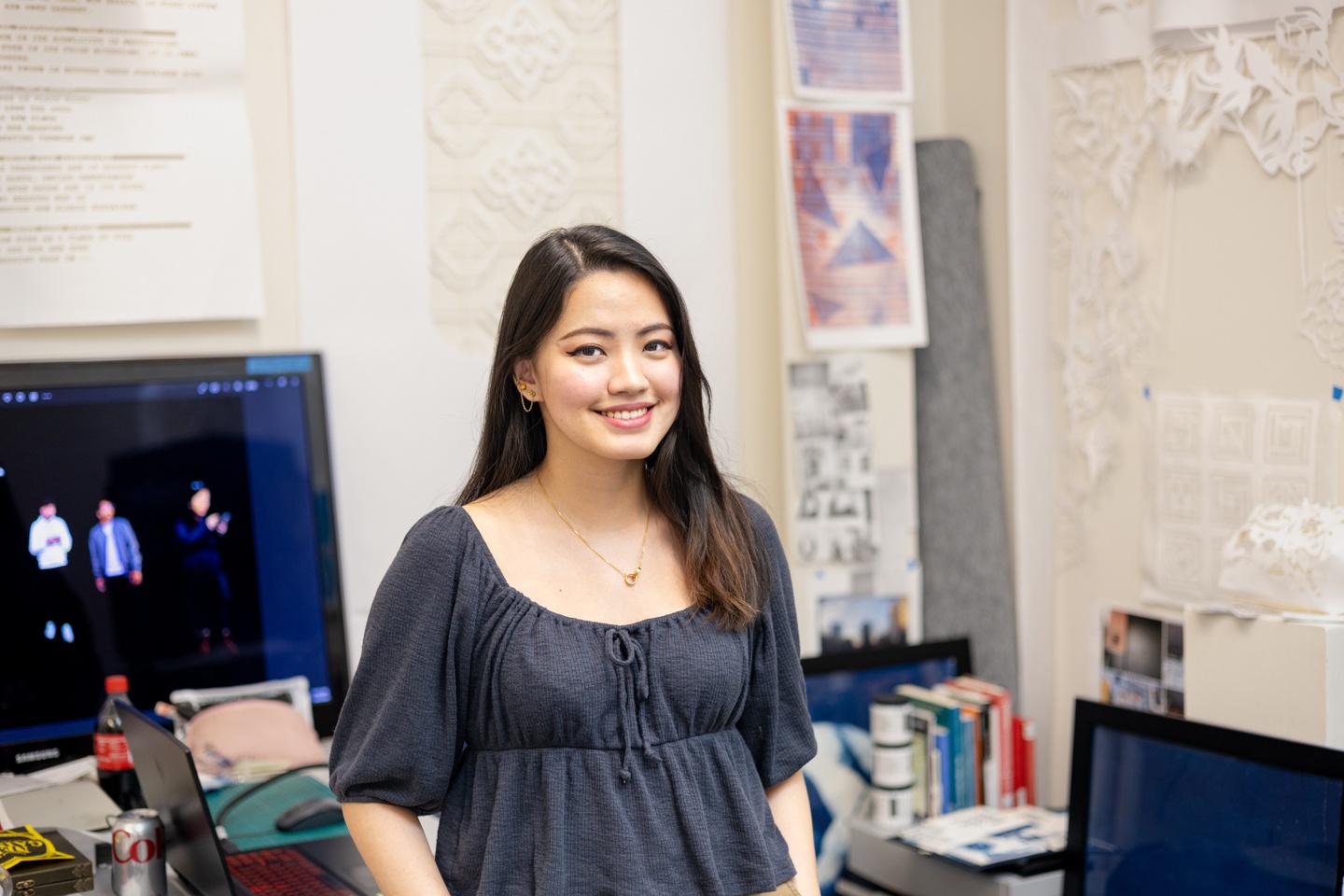Q&A with Sharlene Lee
Sharlene Lee’s mixed-media practice has largely remained in film, painting, and graphic design. She obtained a Digital Media diploma before pursuing a BFA in Visual Communication at Nanyang Technological University Singapore. With the internet being a unique way our generation has learned to connect and support one another, Sharlene explores and creates visual representations of these digital connections and relationships. The concept of time plays a heavy role in her work, and she often plays with light and layering to connote time differences and movement. She draws inspiration from her relationship with others, and collaboration across different time zones is an important aspect of her craft, utilizing the uniqueness of each experience to tell stories.
Sharlene Lee, Well-spoken, 2023, 3-channel video installation with sound, 3:03 min.
Sharlene Lee in her studio (Photo: Caitlin Custer)
Tell us about your project.
My project is centered around awareness and appreciation for the vast range of cultural and communication differences that exist around us. I am interested in the impact of language and accents on our attitudes and perceptions of people who look or speak differently from us.
In Well-spoken, I invite viewers to confront their own biases about people they may perceive as Other.
Where did you get the idea for this project?
I’ve always been interested in ideas surrounding home and belonging—I am curious how language can significantly affect someone’s connection with their surroundings. An immigrant like me may feel a sense of disorientation and frustration trying to assimilate into a new environment.
Personally, I have observed people’s expressions of impatience and frustration once they realize that I don’t have a distinctly “American” accent. In many situations, I often end up clamming up and saying nothing at all.
The current work is an extension of a previous artwork where I filmed individuals speaking in their native language in various environments. My aim was to illustrate the narratives and exchanges that take place during mundane situations where a stranger may require your help.
It was interesting to get initial feedback and comments regarding the project’s effect on viewers who are unable to understand the languages featured. Some may feel wary, others feel confused and frustrated.
And how has it evolved?
In this version, I have placed the individuals against a black background, giving them a hologram-like appearance and removing all contextual elements. This presentation creates the illusion that the characters are physically present and engaging with the viewer directly.
When people enter the installation space, they will encounter many different languages spoken at them with no way to respond. The individuals in the video projection will appear to speak to them directly by posing questions like “Why aren’t you responding?” or “Do you not speak my language?”

Lee in her studio (Photo: Caitlin Custer)
Where did you find so many different people and languages?
I asked around! Many immigrants, including those from St. Louis Mosaic Project, OCA St. Louis, and the International Institute, were enthusiastic and supportive of my artistic endeavors. I am very grateful.
I first interviewed them about their experiences of people making assumptions about them from their accent or where they are from. I incorporated their individual experiences, whether being overlooked for a job for not being a native English speaker, or racist experiences with people on the street.
Do you find yourself returning to certain themes in your work?
I’m always interested in the potential for transformation of a viewer to participant, encouraging contemplation of contemporary power struggles such as modern versus traditional, East versus West, and female versus male.
My Southeast Asian heritage also serves as a significant influence on much of my work. I draw inspiration from traditional customs, histories, and motifs, which are closely tied to my cultural identity.
What was your path like to landing at WashU?
After high school, I pursued a diploma in digital media and later a BFA in visual art. I worked for five years before joining WashU!
When I was looking for graduate schools, I was looking specifically in the Midwest. I had only been to the east and west coasts before, and I wanted to experience something completely different.
What do you hope for the piece?
When people enter the installation, I hope they listen to what they’re telling themselves about what they’re experiencing. What are they feeling about these people? How do those feelings affect their judgement? I hope it gives people a better understanding of what immigrants go through; all the day-to-day challenges they face while adapting to a new country.
Through a reversal of power dynamics and positioning the viewer as “the Other,” I want them to contemplate the marginalization and othering acts that stem from the dominance of the English language within the U.S.
Sharlene Lee reflected on the scope of her practice, time at WashU, and thesis project leading up to the MFA in Visual Art thesis exhibition. This is an edited transcript of Lee’s words as told to Caitlin Custer.



